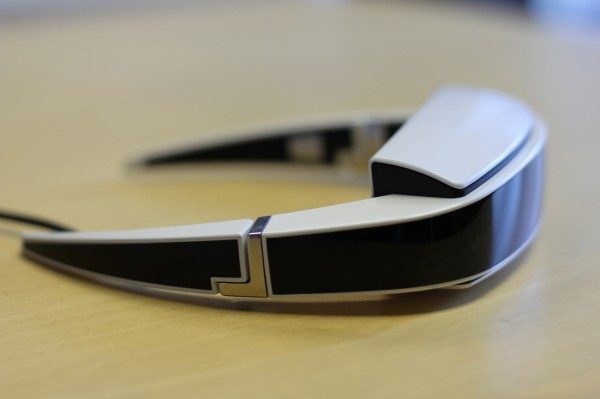 The ST1080 HMD, which was just recently announced by Silicon Micro Display, is a consumer targeted HMD with dual 1080p displays. Pricing for the ST1080 has not yet been announced, though CEO Paul Jin says that that information will be revealed on 12/1/11.
The ST1080 HMD, which was just recently announced by Silicon Micro Display, is a consumer targeted HMD with dual 1080p displays. Pricing for the ST1080 has not yet been announced, though CEO Paul Jin says that that information will be revealed on 12/1/11.
The HMD boasts dual 1080p displays, which means that the ST1080 is packing 56% more pixels than Sony’s soon to be launched HMZ-T1 HMD which uses 720p displays. Thanks to the dual-displays, the ST1080 also supports 3D quite easily. The companion control box that will be used with the ST1080 has HDMI type-A (full) and type-D (micro) inputs, which means you’ll be able to easily connect to a range of devices from tablets and game consoles to computers and Blu-ray players.
While Silicon Micro Displays’s offering doesn’t use OLED displays like the HMZ-T1, it boasts an interesting display technology called LC0S (Liquid Crystal On Silicon) which allows the displays to be semi-transparent. The company says that the ST1080 displays are 10% transparent, which makes me think that this will be a formidable platform for augmented reality applications. The displays are only 0.74″ diagonally with 2,073,600 pixels per display — an incredible 2976.9 pixels per inch! Just for comparison, the iPhone 4’s pixel-packed 3.5″ 960×640 ‘retina’ display is only 329 PPI.
Comments on Silicon Micro Display’s blog from CEO Paul Jin indicate that the company intends to launch a next-gen product which will have adjustable transparency that will go all the way down to 0% which is obviously desirable in certain situations. This would be a great feature because you could use one display for both immersive media viewing/gaming and for augmented reality.
I’m sure that wearable computing enthusiasts will indeed be quite enthused by the possibilities of the transparent ST1080 HMD. Now we just need to wait to find out if the price will actually be affordable. Keep your fingers crossed and stay tuned!
Thanks to pkec for pointing this out in the comments!







Pingback: ST1080 HMD by Silicon Micro Display — Specs and Gallery, Price Coming 12/1 « Road to Virtual Reality()
Pingback: ST1080 HMD Development Kit on Sale and Retail Model Available for Pre-order in December « Road to Virtual Reality()
Pingback: ST1080 and ST1080 DDK Head Mounted Display Pricing Announced « Road to Virtual Reality()